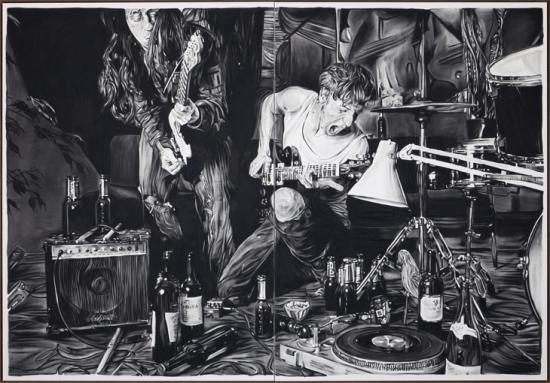
Laura London. “Once Upon A Time… Garage Text,” 2012. Color photograph on vinyl stretched on aluminum strainers. Copyright Laura London.
When photographer Laura London’s show opened at Coagula Curatorial in Chinatown last month, it was called Once Upon a Time…Axl Rose was my Neighbor. By the time it closed on October 20, its title had been cut down to just Once Upon a Time… and all direct reference to Axl Rose, famous for Guns N’ Roses but more so for being his complicated self, excised from the press release. The release now “apologize[d] for the confusion” the first title may have caused.
From the get-go, the show was supposed to occupy that slippery space between truth and fantasy. But Axl Rose’s lawyer didn’t catch the nuance.
The initial press release told a story that served as something of a hook for the smoothly staged photographs in the show, and for the few images that weren’t as staged. London – when, once upon a time, long ago, she was Rose’s neighbor – had come upon the rocker’s garage after he’d been fighting with then-wife Erin Everly. The garage had been vandalized by Rose himself, who had scrawled a warped version of the lyrics of Sweet Child O’ Mine across it in black spray paint: “Sweet Child 0’ Die you R 1 of many nothing special.” Because “it was just too weird to pass up,” London shot a photograph. It’s a particularly striking image with Jeff-Wall-esque neutrality, and it became the centerpiece of the Coagula show. Other images in the show depict London in Axl-like drag, with straight blond hair and bandana around her head.
The week the show opened, Coagula Curatorial received a letter from Rose’s legal counsel. Mat Gleason, who runs the space and as far as I know has never dodged a controversy, posted the letter online. It has some precious lines, like these: “Your salacious and inflammatory statements are plainly designed to garner attention and line your pockets with money. They were crafted for the malicious purpose of profiting from our client’s fame and popularity at the expense of his reputation.”
The lawyer, albeit unintentionally, builds up a fantasy of London that’s perhaps further from the truth than the libelous one he’s accusing London of propagating. Rose and Everly did have a tumultuous relationship (it involved a lawsuit over domestic abuse). But London won’t get art world cred for dropping Rose’s name and no one ever gets rich off a Chinatown exhibition. What London’s doing is something completely un-“malicious,” even a bit confusing, but something a surprisingly large number of artists and writers are trying to do right now: show how muddled spaces between personal experience, other people’s experience and experiences no one actually had can get.

Rinus van de Velde. “Me and Conrad M. during one of our silent rehearsals with Xx Xxxxxx…” Charcoal on Canvas. Courtesy the artist.
A show that closes this weekend at Patrick Painter Inc. in Santa Monica wades into that muddle too. Antwerp-based artist Rinus van de Velde has created an elusive musician named Conrad, described himself as Conrad’s best friend and doppelganger, and done a number of big, detailed drawings evoking the character Rinus van de Velde’s search for Conrad. You can’t tell if it’s Conrad or Rinus who features in each drawing, sleeping with his bag as his pillow, strung out next to a guitar and amp. Are these self-portraits or total fictions?
Another show that just opened at Ambach and Rice in mid-Wilshire wades in, too. Pablo Pijnappel’s 16 mm film Quirijn purportedly follows a man the filmmaker/director went to art school with, a man who took long walks, searched for the best coffee and left art school having produced next to no work of any kind. “Q,” a slim man who walks a lot and wears an attractive leather shoulder bag, is the subject of the film. He says at the very beginning via white subtitles that he agreed to be filmed for the money. He doesn’t expect this film to go anywhere though, because, while he trusts the director, he doubts the director really understands all that goes into making a success out of a film like this. After 12 minutes of watching Q do very little but do it well, the director cuts in and tells about how he knew, after receiving a postcard from Q — one that talked about how hard it is to find good coffee — that Q had to be the subject of his next work. But, as Q had no email address, he had to go searching by walking all around Berlin. He thought he found Q once, but he didn’t. So we’re left on that not–not knowing who we just watched, or how real Q is at all.
Van de Velde’s and Pijnappel’s work occupies a more controllable space between reality and fiction. No Conrad or Q are going to be sending the artists cease and desist letters, and as a viewer, I’m happy to occupy that nebulous space with them. I would have been happy to occupy it with London too, but am glad I didn’t get the chance. Maybe it’s on the theatrical side, but Axl Rose fighting back reminds us that the space between fantasy and reality isn’t safe and can’t be, as long as there are ways in which we drastically misunderstand each other’s realities, and as long as there are realities we desperately want to protect.




